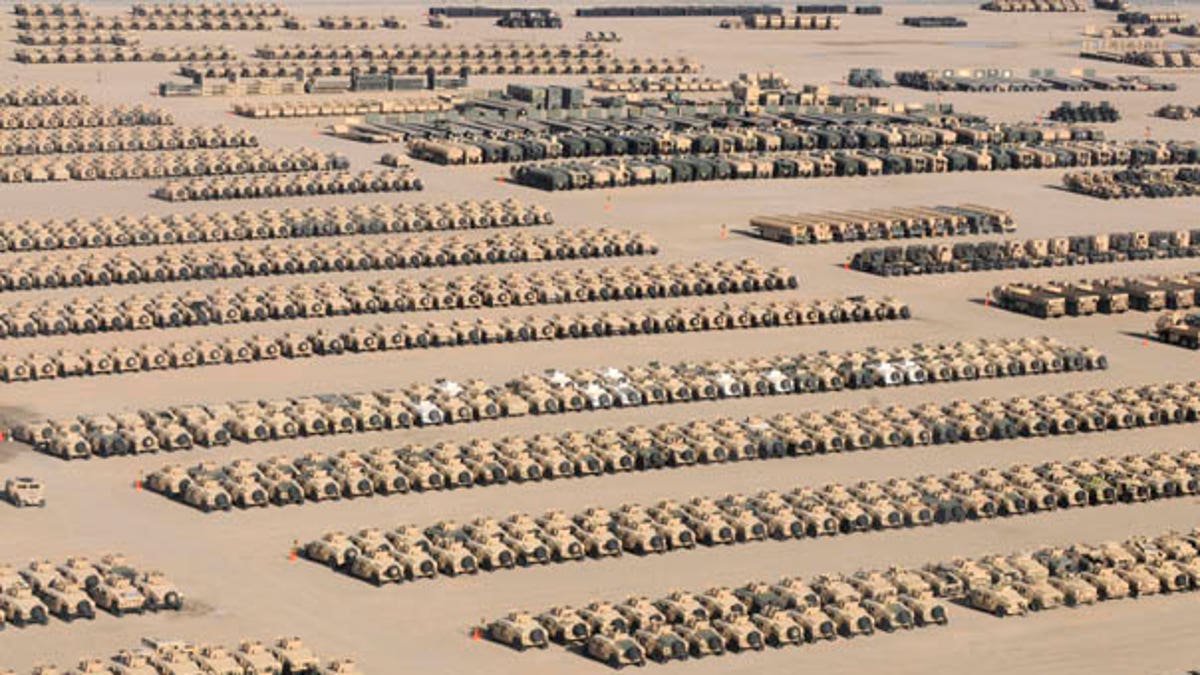
U.S. military equipment like this will have to be removed from Iraq over the next year. (Courtesy of the Pentagon) ( )
WASHINGTON D.C. -- Like after a play, U.S. forces in the theater of war need to strike the set.
And it's expensive work.
The U.S. Army plans to spend tens of billions of dollars over the next year and a half to refurbish and move equipment out of Iraq as the military focus shifts to a build-up in Afghanistan.
Third Army Commander Lt. Gen. William Webster told Pentagon reporters Friday there are 2.8 million pieces of equipment in 88,000 containers that need to be moved out of Iraq, calling it the largest operation "since the build-up for World War II."
The equipment drawdown coincides with the troop drawdown President Obama outlined in 2009. The president wants 50,000 troops left in Iraq by the end of the summer while surging 30,000 forces into Afghanistan in that same period. The rest of the U.S. presence in Iraq is supposed to be gone by the end of 2011.
Webster said the military will salvage whatever it can during that time, taking items to Kuwait to be rebuilt and shipped directly to the battlefield in Afghanistan. Items that are not fit for battle will make their way back to the United States for training purposes.
The toughest part of the job, Webster said, is determining what to keep and what to leave behind for the Iraqis -- decisions based in part on whichever option is cheaper. The Army Material Command and Defense Logistics Agency has thousands employees making those decisions.
For example, humvees and mine-resistant vehicles are considered to be worth refurbishing and bringing to Afghanistan. The mine-resistant truck, better known as the M-RAP, is taking over as the new workhorse of the military. The reinforced V-shaped hull beneath them shields its passengers from roadsides bombs, protection that's desperately needed in Afghanistan.
However, the thousands of SUVs used by military and civilian officials in and around Baghdad aren't worth taking anywhere. A truck bought for $30,000 in 2004 is worth only $5,000-$8,000 dollars today, and the cost of shipping one of the SUVs exceeds that value.
In addition, many of these trucks were not built to U.S. emission standards and would face the added cost of upgrading the exhaust system. "So in some cases, it's cheaper for us to turn that over to the government of Iraq through the -- the right programs and let them keep it," Webster said.
Another example of equipment that the U.S. plans to leave behind is the common jersey barrier, or T-wall as it's known in Iraq. The walls, shaped like an upside-down "T," lined the roads throughout Baghdad at the height of the war and served to protect government and commercial buildings from bombs and other attacks.
Webster said depending on their size it costs between $800 and $5,000 to pour a T-wall, but it would also cost $5,000 to ship it.
"And so it doesn't make any sense," Webster told reporters Friday. "It's cheaper, more beneficial to our government to buy them in Afghanistan or adjacent countries. And that, of course, then contributes to businesses in Afghanistan."
Despite the enormous cost of the undertaking, Webster said decisions like this have saved the Army and the taxpayer lots of cash.
"We saved about $3.8 billion last year by finding those redundancies and efficiencies in our processes and either cost avoidance or cost savings, and we were able to apply that $3.8 billion towards last year's build-up in Afghanistan," he said.
But moving equipment is one of the most costly undertakings in a foreign war. Webster acknowledged that at the height of the Iraq surge, about $20 billion dollars was spent repairing equipment and supplying troops on the ground.




